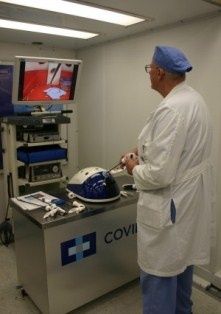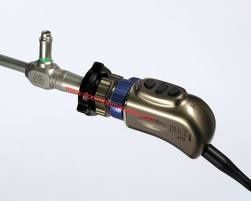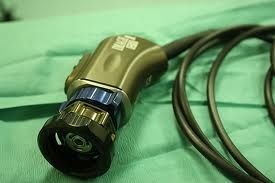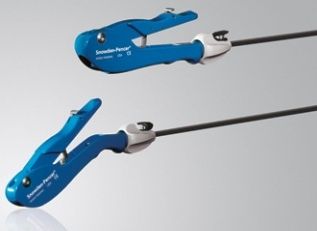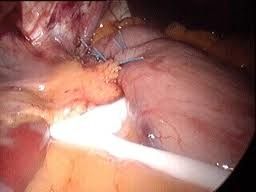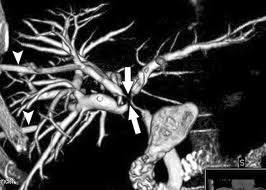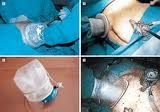Tue - April 26, 2011
9:53 am
|
Article Hits:9229
Routine Cholangiography, a diagnostic imaging procedure for assessing the bile ducts, is deemed unnecessary. Recent studies and medical guidelines have shown that the routine use of Cholangiography does not provide significant clinical benefits compared to its potential risks and costs. As a result, medical professionals are advised against routinely performing this procedure unless there are specific indications or clinical suspicions that warrant its use.
MORE
Tue - April 26, 2011
9:38 am
|
Article Hits:6030
A study revealed that approximately 40% of patients who underwent laparoscopic gastric banding, a surgical procedure for weight loss, experienced complications. These complications may include band erosion, slippage, infection, or other adverse events. The findings highlight the importance of careful patient selection and post-operative monitoring to minimize the risks associated with this procedure. It emphasizes the need for healthcare professionals to thoroughly educate patients about potential complications and ensure appropriate follow-up care to enhance patient safety and improve outcomes.
MORE
Tue - April 26, 2011
9:32 am
|
Article Hits:6384
Weight loss surgery has been found to have a significant positive impact on migraines. Studies have shown that individuals who undergo weight loss surgery experience a reduction in the frequency, intensity, and duration of their migraines. The exact reasons behind this improvement are not fully understood, but it is believed that the surgery's effects on hormonal balance and inflammation play a role. This finding highlights the potential benefits of weight loss surgery beyond its primary purpose of helping individuals lose weight.
MORE
Sat - April 23, 2011
12:48 pm
|
Article Hits:9455
The integration of force feedback technology in the new surgical robot has revolutionized the field of surgery, enabling better surgical outcomes. This innovative robot provides surgeons with real-time tactile information and precise control during procedures, enhancing their ability to navigate delicate tissues and perform complex maneuvers. The force feedback system allows surgeons to feel the resistance and response of tissues, improving accuracy and reducing the risk of complications. With this advancement, surgical procedures can be performed with increased precision and safety, leading to improved patient outcomes.
MORE
Sat - April 23, 2011
12:41 pm
|
Article Hits:6004
Robotic Surgery has firmly established its position for the future of medical advancements. With the advent of technological advancements like the WALS (Wireless Automated Laparoscopic System), robotic surgical procedures have gained significant recognition. WALS has provided a seamless and efficient platform for surgeons, enabling enhanced precision, reduced invasiveness, and faster recovery times for patients. The successful implementation of robotic surgery, exemplified by WALS, has solidified its potential to revolutionize the field of surgery and ensure a promising future.
MORE
Sat - April 23, 2011
12:08 pm
|
Article Hits:5553
Transoral Robotic Surgery (TORS) is a minimally invasive surgical technique used to treat conditions in the head and neck region. It involves the use of a robotic system to access and operate on the targeted area through the mouth, eliminating the need for external incisions. TORS offers several benefits such as reduced scarring, faster recovery, and improved precision compared to traditional open surgery. It has proven effective in treating various conditions including tumors, sleep apnea, and throat disorders. TORS continues to advance as a promising option in the field of surgical intervention.
MORE
Sat - April 23, 2011
11:54 am
|
Article Hits:7601
SILS (Single-Incision Laparoscopic Surgery) and conventional laparoscopic cholecystectomy are two techniques used for gallbladder removal. SILS involves making a single small incision, usually at the umbilicus, through which multiple instruments are inserted. Conventional laparoscopic cholecystectomy involves four small incisions. Both techniques aim to minimize scarring and reduce postoperative pain. However, SILS offers potential cosmetic benefits with a hidden scar but may present technical challenges due to instrument crowding. Conventional laparoscopic cholecystectomy is a well-established technique with proven safety and efficacy. The choice between the two depends on surgeon expertise and patient-specific factors.
MORE
Sat - April 23, 2011
11:40 am
|
Article Hits:21269
A study conducted on surgeons reveals that alcohol consumption increases the likelihood of making mistakes during surgical procedures. Researchers found that even low levels of alcohol impaired the surgeons' abilities, leading to a higher rate of errors. The study emphasizes the importance of maintaining a sober state while performing surgery to ensure patient safety. The findings highlight the need for strict policies and guidelines regarding alcohol consumption among medical professionals to minimize the potential risks and maintain the highest standards of care in surgical settings.
MORE
Sat - April 23, 2011
11:30 am
|
Article Hits:8111
The mobile SILS training center is a state-of-the-art facility designed to provide comprehensive training in Single Incision Laparoscopic Surgery (SILS). It is a portable unit equipped with advanced surgical instruments, simulation technology, and instructional resources. The center travels to various locations, reaching healthcare professionals and medical institutions, offering hands-on workshops, live demonstrations, and educational sessions on SILS techniques. With its innovative design and accessibility, the mobile SILS training center aims to enhance surgical skills, promote proficiency, and foster the adoption of minimally invasive surgical approaches in the medical community.
MORE
Fri - April 22, 2011
1:10 pm
|
Article Hits:10779
In laparoscopy, high-definition technology has become increasingly important. With its enhanced image resolution and clarity, it enables surgeons to perform minimally invasive procedures with greater precision and accuracy. The high-definition imaging system provides a detailed view of the surgical site, allowing surgeons to visualize anatomical structures more clearly. This technology enhances the ability to identify and manipulate delicate tissues, leading to improved patient outcomes, reduced surgical risks, and shorter recovery times. As a result, high-definition technology has revolutionized the field of laparoscopy, making it an indispensable tool for modern surgical practice. MORE
Fri - April 22, 2011
1:01 pm
|
Article Hits:8533
A good optics is necessary for better outcome of surgery. Your camera head includes an objective lens, a prism assembly and three sensors for acquiring the primary colors of the image. Some camera heads likewise incorporate an optical zoom for adjusting the image size (magnification). Optical zoom is advantageous because it doesn't have negative effect on the image resolution. Additionally, some of the image processing might be performed in the actual camera head. Because of better image performance, three-chip cameras were generally accepted because the industry standard for endoscopic surgery about Ten years ago. The main advantage is the fact that color reproduction is more natural.
MORE
Fri - April 22, 2011
9:17 am
|
Article Hits:8983
Snowden-Pencer® Laparoscopic Technologies is a renowned brand known for its advanced surgical instruments used in laparoscopic procedures. With a commitment to innovation and precision, their product range includes graspers, scissors, dissectors, and trocars, designed to enhance surgical efficiency and patient outcomes. These instruments are ergonomically designed, offering surgeons optimal control and tactile feedback during laparoscopic surgeries. Snowden-Pencer® Laparoscopic Technologies continues to be a trusted choice among healthcare professionals, providing reliable and high-quality instruments for minimally invasive procedures.
MORE
Fri - April 22, 2011
8:49 am
|
Article Hits:7986
Laparoscopic adjustable gastric banding (LAGB) is a surgical procedure used to treat obesity. Long-term outcomes of LAGB show mixed results. While some patients experience sustained weight loss and improvement in comorbidities such as diabetes and hypertension, others may face complications and require additional surgeries. Studies indicate that LAGB may not be as effective as other bariatric procedures in terms of long-term weight loss. Additionally, issues like band slippage, erosion, and intolerance can occur. Careful patient selection and ongoing monitoring are crucial for optimizing outcomes in LAGB procedures.
MORE
Thu - April 21, 2011
11:49 pm
|
Article Hits:7130
Laparoscopic right trisectionectomy using the intrahepatic Glissonian approach is a surgical procedure performed with minimal invasiveness to remove a specific portion of the liver known as the right trisection. The procedure involves the use of laparoscopic instruments and a specialized approach that follows the intrahepatic Glissonian vessels. This technique allows for precise dissection and removal of the targeted liver section while minimizing damage to surrounding structures. The laparoscopic approach offers potential benefits such as shorter recovery time, reduced pain, and smaller incisions compared to traditional open surgeries.
MORE
Thu - April 21, 2011
11:42 pm
|
Article Hits:6364
Hand-Assisted Laparoscopic Surgery (HALS) has gained popularity as a minimally invasive surgical technique. Combining the advantages of laparoscopic and open surgery, HALS allows surgeons to insert their hand through a small incision while utilizing laparoscopic instruments. This technique provides tactile feedback, enhanced dexterity, and improved control during complex procedures. HALS offers reduced operative time, less blood loss, and faster patient recovery compared to traditional open surgery. With its growing acceptance among surgeons, HALS is becoming increasingly popular for various abdominal surgeries, contributing to improved patient outcomes and surgical advancements.
MORE

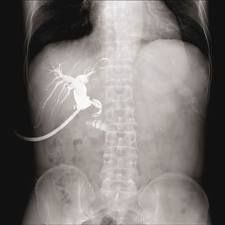
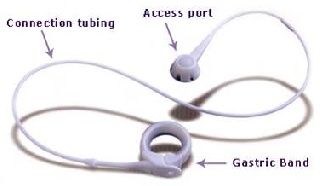

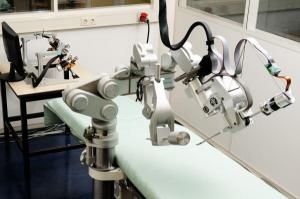
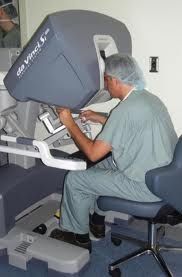
.jpg)

